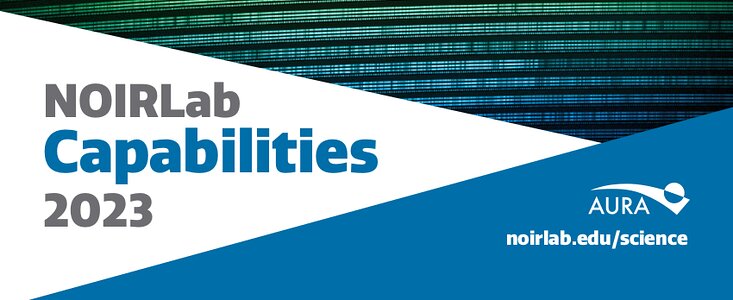New Publications Highlight the Unparalleled Capabilities of NSF NOIRLab
Latest Capabilities brochure highlights the world-class resources and capabilities available to the international astronomical community
5 January 2023
The more we learn about the Universe, the more questions we uncover. To help astronomers continue this journal of discovery, NOIRLab provides some of the most advanced tools, facilities, and instruments to the international research community. These resources enable the astronomy community to advance humanity’s understanding of the Universe by exploring significant areas of astrophysics, including dark energy and dark matter, galaxies and quasars, the Milky Way, exoplanets, and small bodies in our own Solar System.
To promote these unparalleled capabilities, NOIRLab has released a new Capabilities brochure and a series of informative lithograph-style handouts.
The most comprehensive of these publications is the NOIRLab Capabilities Brochure 2023, which spells out the full resources of NOIRLab’s five Programs: the Community Science and Data Center (CSDC), Cerro Tololo Inter-American Observatory (CTIO), the International Gemini Observatory, Kitt Peak National Observatory (KPNO), and Vera C. Rubin Observatory Operations.
NOIRLab is also helping to pave the way with new cutting-edge capabilities, as illustrated by the US Extremely Large Telescope Program (US-ELTP), which will provide all-sky coverage for astrophysical research. Two new lithographs provide new insights into this program. The first is an overview of the site selection process for the Giant Magellan Telescope and the Thirty Meter Telescope. The second lithograph outlines the planned adaptive optics systems for these next-generation observatories.
Central to the success of these US-ELTP facilities and programs is their exceptional scientific staff. NOIRLab highlights their amazing work and achievements in a series of 12 engaging staff profiles, which will hopefully inspire the next generation of astronomers, engineers, and scientists.
More information
NSF’s NOIRLab (National Optical-Infrared Astronomy Research Laboratory), the US center for ground-based optical-infrared astronomy, operates the International Gemini Observatory (a facility of NSF, NRC–Canada, ANID–Chile, MCTIC–Brazil, MINCyT–Argentina, and KASI–Republic of Korea), Kitt Peak National Observatory (KPNO), Cerro Tololo Inter-American Observatory (CTIO), the Community Science and Data Center (CSDC), and Vera C. Rubin Observatory (operated in cooperation with the Department of Energy’s SLAC National Accelerator Laboratory). It is managed by the Association of Universities for Research in Astronomy (AURA) under a cooperative agreement with NSF and is headquartered in Tucson, Arizona. The astronomical community is honored to have the opportunity to conduct astronomical research on Iolkam Du’ag (Kitt Peak) in Arizona, on Maunakea in Hawai‘i, and on Cerro Tololo and Cerro Pachón in Chile. We recognize and acknowledge the very significant cultural role and reverence that these sites have to the Tohono O’odham Nation, to the Native Hawaiian community, and to the local communities in Chile, respectively.
Links
Contacts
Charles Blue
Public Information Officer
NSF NOIRLab
T: +1 202 236 6324
Email: charles.blue@noirlab.edu


